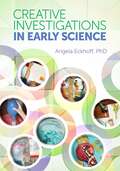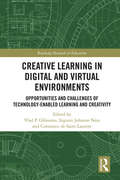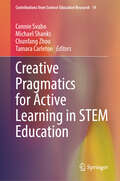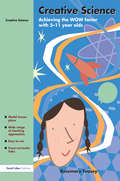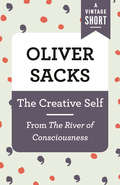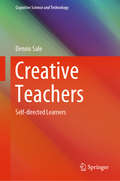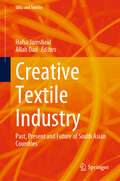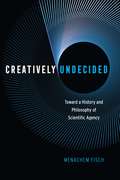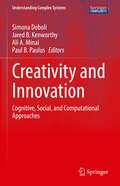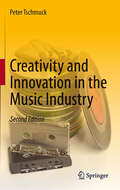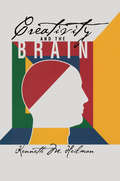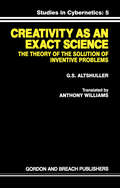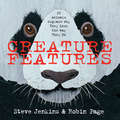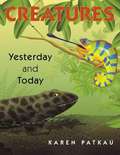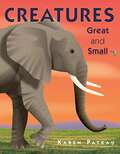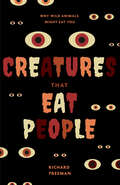- Table View
- List View
Creative Investigations in Early Science
by Angela EckhoffYoung children are born scientists with an innate desire to analyze and investigate the world around them. <p><p> This book helps educators expand and encourage young learners’ inquisitive nature as they explore the physical, life, and earth sciences. Each chapter provides educators practical and approachable ways to intentionally foster young scientists; hands-on, minds-on explorations in the following areas: Matter and physical properties, Physical and chemical changes, Conservation and sustainability, Earth and space systems.
Creative Learning in Digital and Virtual Environments: Opportunities and Challenges of Technology-Enabled Learning and Creativity (Routledge Research in Education)
by Vlad P. Glăveanu; Ingunn Johanne Ness; Constance de Saint LaurentOriginally published as a special issue of the Creativity Research Journal, this volume gives a balanced and reflective account of the challenges and opportunities of technology-enabled creative learning in contemporary societies. Providing a current and updated account of the challenges posed by the Coronavirus to online education, chapters more broadly offer conceptual reflections and empirically informed insights into the impact of technology on individual and collective creativity and learning. These thoughts are explored in relation to school achievement, the development of digital educational resources, online collaboration, and virtual working. Further, the book also considers how the creative use of technology poses risks to learning through the accidental or deliberate dissemination of misinformation, and online manipulation of common societal values in the era of COVID-19. Creative Learning in Digital and Virtual Environments looks at the connection between creativity, learning, and school achievement, and analyses the impact of virtual environments on creative expression. It will appeal to postgraduate students in the fields of creativity and learning, as well as to students and academics involved with broader research in areas such as the role of technology in education, e-Learning and distance education. Vlad P. Glăveanu is Associate Professor and Head of the Department of Psychology and Counselling at Webster University Geneva, Switzerland, as well as Associate Professor II at the University of Bergen, Norway. Ingunn Johanne Ness is a Senior Researcher at the Centre for the Science of Learning & Technology, University of Bergen, Norway. Constance de Saint Laurent is a Postdoctoral Researcher at the University of Bologna, Italy.
Creative Pragmatics for Active Learning in STEM Education (Contributions from Science Education Research #14)
by Connie Svabo Michael Shanks Chunfang Zhou Tamara CarletonThis edited volume is an invitation to redesign STEM higher education. It shows the way to active learning in diverse scenarios and provides educators, leaders and policymakers with a visionary approach to active learning and hands-on examples of how education can help students navigate complexity and unpredictability—the challenges of contemporary society. Featuring contributions from a diverse array of scholars and practitioners, this book explores: · Creative learning strategies · Dynamic teacher-student interactions <span style="mso-bidi-font-size
The Creative Process: Perspectives from Multiple Domains (Palgrave Studies in Creativity and Culture)
by Todd LubartThe creative process refers to the sequence of thoughts and actions that are involved in the production of new work that is both original and valuable in its context. This book examines this process across the domains of visual art, writing, engineering, design and music. It characterizes each domain’s creative process based on evidence stemming from creators’ accounts of their own activity and a wide-range of observational material and theories specific to each field. Results from empirical research are then presented across a set of closely linked chapters, using a common set of methodologies that seek to trace the creative process as it unfolds. This highly interdisciplinary edited collection offers valuable insight into the creative process for scholars and practitioners in the fields of psychology, education, and creative studies, as well as for any other readers interested in the creative process. Todd Lubart brings together a group of authors who are themselves actively involved in their respective creative fields and invites readers to adopt a broad perspective on the creative process in order to unravel some of its mysteries.
Creative Science: Achieving the WOW Factor with 5-11 Year Olds
by Rosemary FeaseyThrough a refreshing blend of theory and practice this book provides stimulating material to develop creative approaches to science in the classroom. It includes: a range of teaching approaches that relate directly to the topic under discussion examples of pupils' work that portray how theory can be translated into practice quick off-the-shelf example model lesson plans which can be adapted. User-friendly and clearly laid out this book is a core text for primary teachers, NQTs and students who want to inject some creativity into their teaching and put that "WOW" factor back into their science lessons.
The Creative Self: From The River of Consciousness (A Vintage Short)
by Oliver SacksA Vintage Shorts selection. Susan Sontag read voraciously. Alexander Pope wrote “Imitations of English Poets.” Henri Poincaré sought distraction from the mathematical problems that occupied his mind. In these and other fascinating case studies, bestselling author Oliver Sacks seeks answers to the question of how creativity can be kindled and encouraged in a person's life. Imbued with the passion and keen insight that made Sacks beloved to countless readers, this selection from The River of Consciousness will be of eager interest to all those with zeal for creative pursuit. An ebook short.
Creative Teachers: Self-directed Learners (Cognitive Science and Technology)
by Dennis SaleThis book offers teaching/training professionals an evidence-based pedagogic guide to teaching effectively, efficiently and creatively – also known as Creative Teaching Competence. Firstly it summarizes the extensive research on human psychological functioning relating to learning and how this can be fully utilized in the design and facilitation of quality learning experiences that maximize attainment and engagement opportunities. Secondly, it demonstrates what creativity actually ‘looks like’ in terms of specific teaching practices, modeling the underpinning processes (syntax) of creative learning design. It then establishes Metacognitive Capability as the superordinate twenty-first century competency; in that this unique human attribute can significantly enhance the cognitive and motivational strategies essential for facilitating self-directed learning and wellbeing. The book helps teaching/training professionals to thoughtfully apply evidence-based knowledge and strategies to today’s challenges, such as developing self-directed learners, enhancing intrinsic motivation, utilizing technology for learning and teaching, developing curricula for twenty-first century competencies and optimally framing and developing the heightened teacher expertise required today.
Creative Textile Industry: Past, Present and Future of South Asian Countries (SDGs and Textiles)
by Hafsa Jamshaid Allah DadThis book gives a comprehensive overview of the creative textile industry and its sectors involved in South Asian countries namely Pakistan, India, and Bangladesh. It provides basic knowledge about the textile, fabric manufacturing techniques, processing, and design method used for the development of creative textile products from the three countries in the past till the 1900s to the present 2023 and discusses the future challenges and prospects. It introduces the concept of a multi-species design process as the future need to obtain a sustainable product cycle of creative textile fabrics. The content of this book appeals to academic researchers, industrial practitioners, and policymakers who are interested in the creative textile industry in South Asia, its economics, and sustainability.
Creatively Undecided: Toward a History and Philosophy of Scientific Agency
by Menachem FischThomas Kuhn and Karl Popper are believed by many who study science to be the two key thinkers of the twentieth century. Each addressed the question of how scientific theories change, but they came to different conclusions. By turning our attention to ambiguity and indecision in science, Menachem Fisch, in Creatively Undecided, offers a new way to look at how scientific understandings change. Following Kuhn, Fisch argues that scientific practice depends on the framework in which it is conducted, but he also shows that those frameworks can be understood as the possible outcomes of the rational deliberation that Popper viewed as central to theory change. How can a scientist subject her standards to rational appraisal if that very act requires the use of those standards? The way out, Fisch argues, is by looking at the incentives scientists have to create alternative frameworks in the first place. Fisch argues that while science can only be transformed from within, by people who have standing in the field, criticism from the outside is essential. We may not be able to be sufficiently self-critical on our own, but trusted criticism from outside, even if resisted, can begin to change our perspective—at which point transformative self-criticism becomes a real option.
Creativity and Innovation: Cognitive, Social, and Computational Approaches (Understanding Complex Systems)
by Simona Doboli Jared B. Kenworthy Ali A. Minai Paul B. PaulusThis book focuses on the emergence of creative ideas from cognitive and social dynamics. In particular, it presents data, models, and analytical methods grounded in a network dynamics approach. It has long been hypothesized that innovation arises from a recombination of older ideas and concepts, but this has been studied primarily at an abstract level. In this book, we consider the networks underlying innovation – from the brain networks supporting semantic cognition to human networks such as brainstorming groups or individuals interacting through social networks – and relate the emergence of ideas to the structure and dynamics of these networks. Methods described include experimental studies with human participants, mathematical evaluation of novelty from group brainstorming experiments, neurodynamical modeling of conceptual combination, and multi-agent modeling of collective creativity. The main distinctive features of this book are the breadth of perspectives considered, the integration of experiments with theory, and a focus on the combinatorial emergence of ideas.
Creativity and Innovation in the Music Industry
by Peter TschmuckWhy did jazz become a dominant popular music genre in the 1920s and rock 'n' roll in the 1950s? Why did heavy metal, punk rock and hiphop find their way from sub-cultures to the established music industry? What are the effects of new communication technologies and the Internet on the creation of music in the early 21st century? These and other questions are answered by Peter Tschmuck through an integrated model of creativity and innovation that is based on an international history of music industry since Thomas A. Edison invented the phonograph in 1877. Thus, the history of the music industry is described in full detail. By discussing the historic process of music production, distribution and reception the author highlights several revolutions in the music industry that were caused by the inference of aesthetic, technological, legal, economic, social and political processes of change. On the basis of an integrated model of creativity and innovation, an explanation is given on how the processes and structures of the present music industry will be altered by the ongoing digital revolution, which totally changed the value-added network of the production, dissemination and use of music. For the second edition, the author has reworked chapter 9 in order to include all the developments which shaped the music industry in the first decade of the 21st century - from Napster to cloud-based music services and even beyond.
Creativity and the Brain
by Kenneth M. HeilmanIn Creativity and the Brain, Kenneth Heilman explores the possible brain mechanisms which underlie creativity, by reviewing the existing evidence and putting forward new ideas. On the way, he discusses the relationships between creativity and intelligence, brain anatomy, neuropharmacology, addiction, handedness, sex differences, and mood states such as depression. He also addresses the effects of neurological disorders and aging, as well as the influence of environmental factors such as tolerance and nurturing.The book will be of interest to neuroscientists, psychologists, psychiatrists, neurologists and educators The engaging and succinct style of this book also make it appealing to students, and researchers from a variety of disciplines who have an interest in understanding the brain mechanisms underlying creativity.
Creativity and Time: A Sociological Exploration (Palgrave Studies in Creativity and Culture)
by Juan A. Roche CárcelThis book defends that the pursuit of originality constitutes one of the most important characteristics of creativity, but that originality refers, etymologically, to both origin and originary. Hence, the book is structured into two parts, dedicated, respectively, to the creative categories of origin and the creative categories of originary. Within the former are creation myths, games – the origin of all cultural activity, the dialectic chaos-order, axial civilizations – the germ of our time, and the struggle between generations – a factor of social transformation, and, within the second, creative capitalism, creative work in the context of the global economy of risk and uncertainty, and representative democracy. However, these two concepts are not isolated, but deeply interrelated, in a way that explains how creative originality builds a temporal narrative. It has been dislocated in late modernity and, with it, creativity has been broken.
Creativity As an Exact Science
by G.S. AltshullerThis book discusses the principles of controlling thinking in the solution of inventive problems that are transposed to the organization of creative thinking in any sphere of human activity. It is aimed at the engineer and also comprehensible to people who do not work with technology.
The Creator and the Cosmos: An Astrophysicist Reconciles Science and Scripture
by Hugh RossFew eternal themes intrigue individuals - believers and nonbelievers alike more than the mystery of creation and the Being of an eternal God.. Dr. Hugh Ross, a highly qualified and gifted cosmologist (a student of the universe) and astronomer/scientist gives us in this magnificent book irrefutable evidences of God's present and powerful working in His created universe. Most helpfully it is written in language readily understandable by those of us who are laypeople in the field of astrophysics. This is must reading for the seeking mind and heart.
The Creature Department
by Robert Paul Weston Framestore"Stunning...a bit like if you took Charlie and the Chocolate Factory and Monsters Inc. and shoved them in a TARDIS." --Buzzfeed It's a tentacled, inventive, gooey, world in there. . . . Elliot Von Doppler and his friend Leslie think nothing ever happens in Bickleburgh, except inside the gleaming headquarters of DENKi-3000--the world's eighth-largest electronics factory. Beneath the glass towers and glittering skywalks, there's a rambling old mansion from which all the company's amazing inventions spring forth. And no one except Uncle Archie knows what's behind the second-to-last door at the end of the hall. Until Elliot and Leslie are invited to take a glimpse inside. They find stooped, troll-like creatures with jutting jaws and broken teeth. Tiny winged things that sparkle as they fly. And huge, hulking, hairy nonhumans (with horns). It is unlike anything they've ever seen. But when Chuck Brickweather threatens to shut down the DENKi-3000 factory if a new product isn't presented soon, the creatures know they are in danger. And when Uncle Archie vanishes, it's up to Elliot, Leslie, and every one of the unusual, er, "employees" to create an invention so astonishing it will save the Creature Department.
Creature Features: Twenty-Five Animals Explain Why They Look the Way They Do
by Steve Jenkins Robin PageDear axolotl: Why do you have feathers growing out of your head? Axolotl: They aren't feathers—they're gills! They let me breathe underwater. Let's face it. Even as babies, we humans pay close attention to faces. Observing another person's features and expressions tells us whether they are happy, angry, excited, or sad. And when we look at an animal, it's hard not to imagine that its face is communicating human feelings. This isn't true, of course. Squinty eyes, an upturned mouth, or another odd expression is probably there because, in some way, it helps that animal survive. Packed with many cool facts and visuals on where certain animals live and what they eat, this book captures twenty-five humorous—and very true—explanations of why animals look the way they do in order to exist in this world.
Creatures: Yesterday and Today
by Karen PatkauFrom the worlds of insects, fish, mammals, sea jellies, reptiles, amphibians, birds, crustaceans, arachnids, and mollusks, she presents living animals and their prehistoric ancestors. Meet Diplodocus and Skylark; Cameroceras and Blue-Ringed Octopus; Brontoscorpio and Fat-Tailed Scorpio; and learn what links them across the ages.
Creatures Born of Mud and Slime: The Wonder and Complexity of Spontaneous Generation (Singleton Center Books in Premodern Europe)
by Daryn LehouxHow did the concept of spontaneous generation survive for so long?We accept that, at some point in the history of our universe, living creatures emerged from nonliving matter. Yet from the time of Aristotle until the late nineteenth century, many people believed in spontaneous generation, that living creatures sprang into existence from rotting material. As Daryn Lehoux explains in this fascinating book, spontaneous generation was perhaps the last stand of the ancient scientific worldview. In Creatures Born of Mud and Slime, Lehoux shows that—far from being a superstitious, gullible, or simplistic belief—spontaneous generation was a sophisticated and painstakingly grounded fact that stood up to the best scientific testing. Starting with the ancient Greeks’ careful and detailed investigations into how animals are generated straight through to the early modern period, Lehoux brings to life the intellectual contexts, rivalries, observational evidence, and complex and fascinating theories that were used to understand and explain the phenomena.The book highlights both the weirdness and the wonder that lie at the heart of investigations into nature. Lehoux concludes with a new look at a set of conflicting experiments that demonstrate that even the best scientific evidence can end up muddying what we take to be the truth about the world. Creatures Born of Mud and Slime is a compelling look at how we understand conceptions of scientific change, truth, and progress.
Creatures Born of Mud and Slime: The Wonder and Complexity of Spontaneous Generation (Singleton Center Books In Premodern Europe Ser.)
by Daryn LehouxA history and analysis of the theory of spontaneous generation and how scientific thought progresses.We accept that, at some point in the history of our universe, living creatures emerged from nonliving matter. Yet from the time of Aristotle until the late nineteenth century, many people believed in spontaneous generation, that living creatures sprang into existence from rotting material. As Daryn Lehoux explains in this fascinating book, spontaneous generation was perhaps the last stand of the ancient scientific worldview.In Creatures Born of Mud and Slime, Lehoux shows that—far from being a superstitious, gullible, or simplistic belief—spontaneous generation was a sophisticated and painstakingly grounded fact that stood up to the best scientific testing. Starting with the ancient Greeks’ careful and detailed investigations into how animals are generated straight through to the early modern period, Lehoux brings to life the intellectual contexts, rivalries, observational evidence, and complex and fascinating theories that were used to understand and explain the phenomena.The book highlights both the weirdness and the wonder that lie at the heart of investigations into nature. Lehoux concludes with a new look at a set of conflicting experiments that demonstrate that even the best scientific evidence can end up muddying what we take to be the truth about the world. Creatures Born of Mud and Slime is a compelling look at how we understand conceptions of scientific change, truth, and progress.“A very well-written and well-researched book that grapples with the foundational questions of the history of Western philosophy.” —Justin E. H. Smith, author of The Philosopher: A History in Six Types“A historical tour de force . . . the author’s brilliant prose [makes] the reader appreciate at one time the strangeness and the persuasive power of outmoded scientific explanations.” —Paolo Savoia, Nuncius 34“Concise and accessible, Lehoux’s clarity and graceful prose make this book . . . a pleasure to delve into.” —James Strick, HOPOS 8
Creatures Great And Small
by Karen PatkauJoin Toronto author and illustrator Karen Patkau as she explores the world of insects, mammals, sea jellies, reptiles, amphibians, birds, crustaceans, arachnids, and mollusks. From extremely large creatures, such as the blue whale, Chinese giant salamander, and goliath tarantula, to extremely small ones, such as the bumblebee bat, dwarf gecko, and fairy shrimp, embark on this informative, beautifully illustrated voyage of discovery. Even the simple fact-filled text is enchantingly presented in the voices of the animals themselves. A glossary, map endpapers, and handy charts — introducing the concepts of scale and proportion by comparing measurements of animals that are “Big” and “Really Big” to “Small” and “Really Small” — make this book a must-have for parents, schools, and libraries alike.
Creatures Great and Small
by Karen PatkauJoin Toronto author and illustrator Karen Patkau as she explores the world of insects, mammals, sea jellies, reptiles, amphibians, birds, crustaceans, arachnids, and mollusks. From extremely large creatures, such as the blue whale, Chinese giant salamander, and goliath tarantula, to extremely small ones, such as the bumblebee bat, dwarf gecko, and fairy shrimp, embark on this informative, beautifully illustrated voyage of discovery. Even the simple fact-filled text is enchantingly presented in the voices of the animals themselves. A glossary, map endpapers, and handy charts — introducing the concepts of scale and proportion by comparing measurements of animals that are “Big” and “Really Big” to “Small” and “Really Small” — make this book a must-have for parents, schools, and libraries alike.
Creatures of Cain: The Hunt for Human Nature in Cold War America
by Erika Lorraine MilamHow Cold War America came to attribute human evolutionary success to our species' unique capacity for murderAfter World War II, the question of how to define a universal human nature took on new urgency. Creatures of Cain charts the rise and precipitous fall in Cold War America of a theory that attributed man’s evolutionary success to his unique capacity for murder.Drawing on a wealth of archival materials and in-depth interviews, Erika Lorraine Milam reveals how the scientists who advanced this “killer ape” theory capitalized on an expanding postwar market in intellectual paperbacks and widespread faith in the power of science to solve humanity’s problems, even to answer the most fundamental questions of human identity. The killer ape theory spread quickly from colloquial science publications to late-night television, classrooms, political debates, and Hollywood films. Behind the scenes, however, scientists were sharply divided, their disagreements centering squarely on questions of race and gender. Then, in the 1970s, the theory unraveled altogether when primatologists discovered that chimpanzees also kill members of their own species. While the discovery brought an end to definitions of human exceptionalism delineated by violence, Milam shows how some evolutionists began to argue for a shared chimpanzee-human history of aggression even as other scientists discredited such theories as sloppy popularizations.A wide-ranging account of a compelling episode in American science, Creatures of Cain argues that the legacy of the killer ape persists today in the conviction that science can resolve the essential dilemmas of human nature.
Creatures That Eat People: Why Wild Animals Might Eat You
by Richard FreemanWild Animals Might Eat You—Learn Which Ones“Informative and very entertaining”—Readers of Richard’s booksCreatures That Eat People is an action-packed deep dive on predators that turn man eater. Learn about past and present cases on human eating animals—big and small—so you can survive being hunted!Avoid getting eaten!Do you find yourself wondering: Do bears eat humans? Do snakes eat people? Could I survive people-eating predators of any kind? Perfect for anyone with a fun or morbid interest in wildlife or survivalism, Creatures That Eat People is full of stories of strange animals that eat humans and the situations that lead to it.Learn which wild animals might eat you—from an expert. Cryptozoologist, former zookeeper, current zoological director, best-selling author, and animal enthusiast Richard Freeman examines all the cool man eaters in the animal kingdom—so you can be prepared on your next adventure.Inside, you’ll find:Tips for visiting different types of areas with apex predators in themBears, sharks, crocodiles, snakes, and other other weird, wild animals that eat peopleReal-life, thrilling stories of animals eating people—and some survive and some don’tIf you liked How To Survive A Freakin’ Bear Attack, Plants That Kill, Surviving the Wild, or In Search of Real Monsters, and if you enjoyed shows like Tiger King or Human Prey, you’ll love Creatures That Eat People.
Creatures Yesterday and Today
by Karen PatkauIn this lively companion to Creatures Great and Small, author and illustrator Karen Patkau transports the reader to prehistoric times, when many creatures existed that have since disappeared. From the worlds of insects, fish, mammals, sea jellies, reptiles, amphibians, birds, crustaceans, arachnids, and mollusks, she presents living animals and their prehistoric ancestors. Meet Diplodocus and Skylark; Cameroceras and Blue-Ringed Octopus; Brontoscorpio and Fat-Tailed Scorpio; and learn what links them across the ages. Scientists obtain clues from fossils about how these prehistoric creatures looked and lived, and Karen Patkau examines many of them in this fascinating look at extinct and present-day species. Captivating text in the voices of the animals themselves is complemented by the vibrant illustrations, map endpapers, glossary, geological timeline, and chart of the history of life, making this fact-filled book a welcome addition to any home or school library, where a budding scientist can happily explore.
